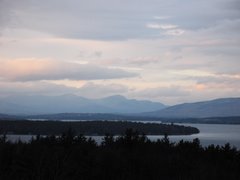
Red pulp. Malpighian corpuscles. Trabeculae and sinusoids. Great words associated with a great organ: the spleen.
This past week I provided anesthesia for an emergency splenectomy. You'd think after giving anesthesia so often it would be old hat, but whenever I help get a patient through a tough operation safe and sound, I always feel deeply grateful.
Here, I was grateful that the difficult A-line went in, finally (thank you, Saint René!). Grateful that precautions I took in anticipation of the surgeon's incision, which revealed over two liters of blood in the abdomen from the patient's ruptured spleen, enabled the patient's vital signs to hold steady. Grateful that when I transported the patient to the ICU still intubated and with blood pressure medication infusing continuously, she was in stable condition, and I felt I could reassure the family - a large, warm family that filled the entire waiting area. Grateful that one family member felt comfortable enough with me to give me a hug afterward.
But a couple of hours afterward when I stopped by the ICU again to check on the patient, things were not as I had left them. I was upset. I disagreed with some of the steps taken by the physician now-in-charge. I always find it difficult to know how to handle such situations. Too many cooks can often spoil the soup, and I hate it when someone tries to backseat drive with me / read over my shoulder / hover. It's also a delicate matter to challenge the physician in charge when their decisions are technically not incorrect but I perceive them to be less effective or aggressive than my alternatives, or they're just not what I would have chosen.
There's often not just one right way to do something in medicine, but the physician running the ICU that night was clearly a think-about-it kind of person rather than a do-something-about-it-right-now kind of person, and I wanted to do something RIGHT THEN to fix the patient's vital signs - to temporize, at least, and protect the patient's organs while more goal-directed measures were being set up. I hate to say it, but I hovered. I hovered and hovered, ready to muscle my way in to protect my patient if need be, but eventually she stabilized and I felt I could leave once more.
*Sigh.* You can feel good for a moment in medicine but never for too long before something takes you back down.
***
In French, spleen "
refers to a state of pensive sadness or melancholy." In case it hasn't been clear from my recent posts, I think I have been a bit "splenetic" of late.
Maybe some Baudelaire will be cathartic (various translations
here):
Spleen
Quand le ciel bas et lourd pèse comme un couvercle
Sur l'esprit gémissant en proie aux longs ennuis,
Et que de l'horizon embrassant tout le cercle
II nous verse un jour noir plus triste que les nuits;
Quand la terre est changée en un cachot humide,
Où l'Espérance, comme une chauve-souris,
S'en va battant les murs de son aile timide
Et se cognant la tête à des plafonds pourris;
Quand la pluie étalant ses immenses traînées
D'une vaste prison imite les barreaux,
Et qu'un peuple muet d'infâmes araignées
Vient tendre ses filets au fond de nos cerveaux,
Des cloches tout à coup sautent avec furie
Et lancent vers le ciel un affreux hurlement,
Ainsi que des esprits errants et sans patrie
Qui se mettent à geindre opiniâtrement.
— Et de longs corbillards, sans tambours ni musique,
Défilent lentement dans mon âme; l'Espoir,
Vaincu, pleure, et l'Angoisse atroce, despotique,
Sur mon crâne incliné plante son drapeau noir.
Or, if you're a wine connoisseur, maybe a little glass of this - Lord Byron supposedly called it "a medicine to drive out spleen" - is just what the doctor ordered (photo
credit):

The Merry Drinker writes, "Chasse-Spleen is made up of 73% Cabernet Sauvignon, 20% Merlot and 7% Petit Verdot, fermented in stainless steel and cement, then aged in oak for 12 to 14 months. The 2003 is bluish-purple, with a strawberry jam nose. Its tannins are still a little harsh – unavoidable in a wine built to last – but they do not impair the pleasure, which is intense. The taste is scrumptiously full and meaty, the finish good and persistent."
The finish good and persistent. I'd drink to that, but chocolate's more my style... :)
*from George Eliot's Daniel Deronda





































